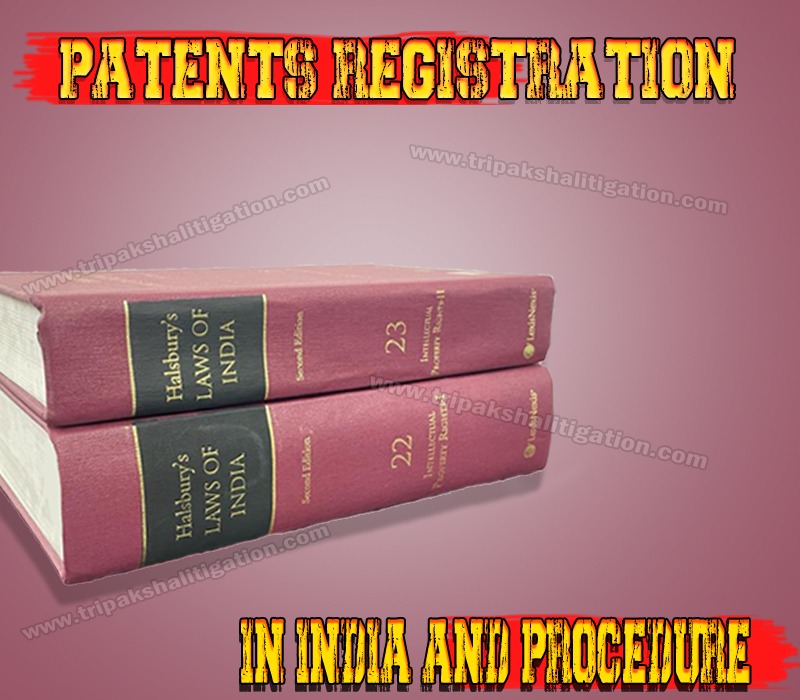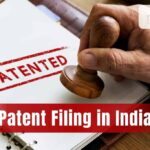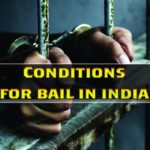Introduction
Patent, is a legal document granted by the government giving an inventor the exclusive right to make, use, and sell an invention for a specified number of years. Patents are also available for significant improvements on previously invented items. A Patent is a statutory right for an invention granted for a limited period of time to the patentee by the Government, in exchange of full disclosure of his invention for excluding others, from making, using, selling, importing the patented product or process for producing that product for those purposes without his consent.
Patents in India
The patent system in India is governed by the Patents Act, 1970 as amended by the Patents (Amendment) Act, 2005 and the Patents Rules, 2003. The Patent Rules are regularly amended in consonance with the changing environment, most recent being in 2019.
The term of every patent granted is 20 years from the date of filing of application. However, for application filed under national phase under Patent Cooperation Treaty (PCT), the term of patent will be 20 years from the international filing date accorded under PCT.
Patent protection is a territorial right and therefore it is effective only within the territory of India. There is no concept of global patent. However, filing an application in India enables the applicant to file a corresponding application for same invention in convention countries or under PCT, within or before expiry of twelve months from the filing date in India. Patents should be obtained in each country where the applicant requires protection of his invention.
Criteria of Patentability
An invention relating either to a product or process that is new, involving inventive step and capable of industrial application can be patented. An invention is patentable subject matter if it meets the following criteria –
- It should be novel. (it means that matter is not published in India or elsewhere before the date of filing of patent application India)
- It should have inventive step or it must be non-obvious. (It means that inventions not obvious to a person skilled in the art in the light of previous publication or knowledge or document.)
- It should be capable of Industrial application.( having industrial capability)
- It should not attract the provisions of section 3 and 4 of the Patents Act 1970.
However, it must not fall into the categories of inventions that are non- patentable under sections 3 and 4 of the Act which talks about ‘what are not inventions’ and ‘Inventions relating to atomic energy not patentable’ respectively.
The protection through patent does not apply to an invention which does not falls into the following categories:
a. frivolous
b. obvious
c. contrary to well established natural laws
d. contrary to law
e. Morality
f. injurious to public health
g. a mere discovery of a scientific principle
h. the formulation of an abstract theory
i. a mere discovery of any new property or new use for a known substance or process, machine or apparatus
j. a substance obtained by a mere admixture resulting only in the aggregation of the properties of the components thereof or a process for producing such substance.
k. a mere arrangement or rearrangement or duplication of known devices
l. a method of agriculture or horticulture
m. inventions relating to atomic energy or the inventions which are known or used by any other person, or used or sold to any person in India or outside India.
Important Sections to be Read for Studying Procedure
Section 6: It provides that any person can apply for a patent if he is a true and first inventor of patent or If the person is the assignee of the true and first inventor or if he is the legal representative of the deceased person who immediately before his death was entitled to make an application for a patent. Such application may be filed by them either individually or jointly.
Section 9: It deals with the specification of the patents. it implies that an inventor must give a proper description of the invention. It provides that a patent shall be accompanied with a provisional specification and later with a complete specification to be filed within 12 months. Further section provides power to controller to convert a provisional application to a specific one and vice a versa. Controller may also cancel an application.
Section 10: It deals with the content of specifications. It provides that it should have a descriptive title. It should disclose best method of performing and should provide all technical information. Drawings or models if required are also to be provided.
Section 11: It provides for various rules for fixing of priority dates. The priority date is important in determining whether the invention is indeed new keeping or not. The date on which single application was filed along with a provisional or complete specification, the priority date shall be the filing date. Where a complete specification based on a previously filed application in India has been filed within twelve months from the date of that application and the claim is fairly based on the matter disclosed in the previously filed application, the priority date of that claim shall be the date of the previously filed application in which the matter was first disclosed. A claim in a complete specification of a patent shall not be invalid by reason only of i) the publication or use of the invention so far as claimed in that claim on or after the priority date of such claim; or ii) the grant of another patent which claims the invention, so far as claimed in the first mentioned claim, in a claim of the same or a later priority date.
Section 11A and 11 B: These sections provide for Publication and examination of applications. No application shall be ordinary open to public for such period as prescribed. It shall be published after expiry of period except those application in which secrecy direction is imposed under section 35; has been abandoned under sub‑section (1) of section 9, has been withdrawn three months prior to the period specified under sub‑section (1). Drawings and models can also be shown to public. 11B provides that no application for a patent shall be examined unless applicant or interested person requests.
Section 12, 29-34: It deals with anticipation which means lack of novelty and something which is not anticipated. Proper examination has to be done by the examiner for search of anticipation. Section 29-34 provides for several exceptions to anticipation.
Section 14: It deals with amendment of application. It provides that where an application for a patent, the report of the examiner received by the Controller is adverse to the applicant or requires any amendment of the application, the specification or other documents to ensure compliance with the provisions of this Act or of the rules made there under, the Controller, before proceeding to dispose of the application, shall communicate the gist of the objections to the applicant and shall, if so required by the applicant within the prescribed period, give him an opportunity of being heard.
Section 21: It provides for time for putting application in order for grant.
(1) An application for a patent shall be deemed to have been abandoned unless, Within such period as may be prescribed, the applicant has complied with all the requirements imposed on him by or under this Act, whether in connection with the complete specification or otherwise in relation to the application from the date on which the first statement of objections to the application or complete specification or other documents related thereto is forwarded to the applicant by the Controller.
Explanation.—Where the application for a patent or any specification or, in the case of a convention application or an application filed under the Patent Cooperation Treaty designating India any document filed as part of the application has been returned to the applicant by the Controller in the course of the proceedings, the applicant shall not be deemed to have complied with such requirements unless and until he has re-filed it or the applicant proves to the satisfaction of the Controller that for the reasons beyond his control such document could not be re-filed.
(2) If at the expiration of the period as prescribed under sub section (1),—
(a) an appeal to the High Court is pending in respect of the application for the patent for the main invention; or
(b) in the case of an application for a patent of addition, an appeal to the High Court is pending in respect of either that application or the application for the main invention, the time within which the requirements of the Controller shall be complied with shall, on an application made by the applicant before the expiration of the period as prescribed under sub-section (1), be extended until such date as the High Court may determine.
(3) If the time within which the appeal mentioned in sub-section (2) may be instituted has not expired, the Controller may extend the period as prescribed under sub-section (1), to such further period as he may determine:
Provided that if an appeal has been filed during the said further period, and the High Court has granted any extension of time for complying with the requirements of the Controller, then the requirements may be complied with within the time granted by the Court.
Procedure for Registration of Patents
Following is the procedure registration of patents in India: For Registration of a Patent in India, the specified form duly completed along with the requisite government fees have to be submitted before the Patent Office, Government of India. The jurisdiction of the filing the application for patent registration would be decided on the basis of the applicant’s address.The application for patent should be filed either with a provisional specification or complete specification. The Applicant can file the application for Patent registration along with the provisional specification where the description of the invention is briefly mentioned without any claims. The complete specification must be filed with all the claims for protection of patent within 12 months from the date of filing the provisional specification. In the event of failure of submission the application for Patent registration will be deemed as abandoned.
The complete specification should fully express the prior art, the details of the invention along with drawings, if any. The most important and critical area of the Patent Specification are the claims which should be carefully drafted for proper protection of the invention. The claim or claims should define the scope of the invention for which the protection is claimed. The claim should cover only one single invention.
The application for patent is examined by examiners of patents to see whether it complies with the requirements of the Act and the Rules, whether there is any lawful ground of objection for the grant of patent, and whether the invention has already been published or claimed by any other person. The examiner makes a search in publications available in the Patent Office and specification of prior applications and Patents to see whether the same invention has already been published or claimed or is the subject matter of existing or expired patents.
After a period of time every Patent Application is being examined by Learned Examiner appointed by The Patent Office, Government of India and the examination report will be sent to the Patent Attorney of the Applicant to overcome the objections raised by the Learned Examiner of the Patent Office, Government of India. These objections should be dealt through an Indian Patent Attorney to safeguard the interest of the inventor. If the objections are not waived through amendments, the Controller of Indian Patent Office shall fix a hearing for further submission before refusing or granting the applicant for patent registration in India
In case of overcoming the all objections raised by learned Examiner of Indian Patent Office, the Controller of the Indian Patent Office will accept the complete specification and advertise it in the Official Gazette published by the Indian Patent Office. From the date of acceptance of the Indian Patent Application till the date of sealing of the Indian Patent , the applicant will have the benefits of the protection of Patent but will not have any right to initiate any proceeding against infringement until the patents is sealed.
Any person interested can file notice of opposition against the respective patent within three months from the date of advertisement in the Official Gazette published by Indian Patent Office. The Controller will forward a copy of the notice of opposition to the applicant who may subsequently file the relevant evidence in support of the Patent Application. Finally, the opposition proceedings of the application for Patent registration shall conclude through hearing and would be decided in favour of Applicant or the Opponent and the Application for patent registration will be rejected or accepted by the Learned Controller of Indian Patent Office.
You may contact me for consultation or advice by visiting Contact Us








